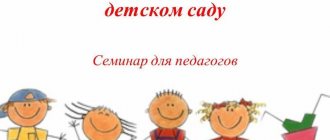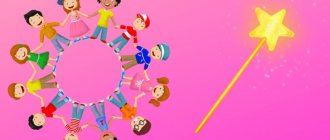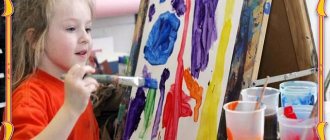Author - A.D. Kandykova
The purpose of the game in kindergarten is to enhance the activities of teachers in multicultural education of children. Preliminary work includes consultation, teaching hour, study of regulatory and methodological documents.
Materials and equipment:
- sheets with tasks for the number of participants, crossword puzzles;
- ICT is used to demonstrate the stages of the game and solved crossword puzzles - a projector, a computer, a screen.
Progress of the game
In the music room there are tables in a semicircle, teachers sit at them. The game is conducted by the presenter.
The business game for teachers takes place in three stages:
- at the first stage, teachers work individually,
- at the second stage they unite in pairs,
- at the third stage - into three groups with an equal number of participants.
The jury evaluates the work of teachers in pairs and groups according to the following criteria: completeness of the answer, coherence of work in pairs and groups (the ability to correctly defend one’s opinion and negotiate with colleagues). The jury's individual work is not evaluated.
Stage 1
1. Read statements from different authors about multicultural education. 2. Underline the words that express the essence of the statement. 3. Write down how you understand the essence of multicultural education. 4. Sketch out the main meaning of multiculturalism (in your opinion).
A.N. Dzhurinsky considers multicultural education as an alternative to international socialist education, the formation of personality outside of national culture, subject to the unity and ideological integration of society. At the same time, multicultural education places emphasis on the interconnection of cultures, one of which dominates.
M.A. Bogomolova proceeds from the fact that multicultural education in its essence is close to interethnic education and provides for interpersonal interaction and is opposed to nationalism and racism. It is aimed at mastering cultural and educational values, at the interaction of different cultures in a situation of pluralistic cultural adaptation to other cultural values.
V.V. Makaev., Z.A. Malkova, L.L. Suprunov identify multicultural education with the formation of the personality of a person capable of active and effective life in a multinational and multicultural environment, who has a developed sense of understanding and respect for other cultures, the ability to live in peace and harmony with people of different nationalities, races, and religions.
A number of authors (N.D. Galskova, L.L. Paramonova, V.V. Safonova, E.A. Sokolova) associate the willingness to accept another culture, another way of life with manifestations of tolerance, because only mutual tolerance of people of different nationalities can resist hatred .
Stage 2
Team up in pairs based on a common characteristic (exclude the sign of working in the same age group). Tell your partner how you understand multicultural parenting. Explain your multicultural framework. Draw a general diagram of multiculturalism.
1. Read the meanings of the words “tolerance” and “ethno-” taken from dictionaries. 2. Based on them, create your definition of ethnotolerance.
The meaning of the word "tolerance"
"Wikipedia" Tolerance - from lat. tolerare - endure, endure, endure, get used to. “Social tolerance” in sociology and psychology is tolerance, the ability to calmly, without hostility, perceive someone else’s way of life, behavior, customs, feelings, opinions, ideas, beliefs, recognize the right to exist of other cultures and coexist sustainably in a multicultural, multi-ethnic society.
Dictionary of Foreign Words Tolerance (Latin tolerantia - patience) - 1) tolerance, condescension towards someone or something; 2) biol., med. complete or partial absence of immunological reactivity, i.e. loss (or decrease) by the animal or human body of the ability to produce antibodies in response to antigenic irritation (cf. sensitization 1).
Modern explanatory dictionary Tolerance (from Latin tolerantia - patience) - 1) an immunological state of the body in which it is unable to synthesize antibodies in response to the introduction of a specific antigen while maintaining immune reactivity to other antigens. The problem of tolerance is important in organ and tissue transplantation...; 2) the body’s ability to tolerate the adverse effects of one or another environmental factor...; 3) tolerance for other people's opinions, beliefs, and behavior.
The meaning of the word “ethno-” The initial part of complex words that introduces the meaning of the word people (ethnogenesis, ethnolinguistics, ethnopsychology, etc.).
Stage 3
Form three groups with an equal number of participants.
I. Solve the crossword puzzle for the section of the “Childhood” program - “Child in a multicultural and multiethnic environment”
Questions of the 1st crossword puzzle 1. One of the components of the content of social development of older preschool children in a multicultural society. 2. Spiritual _______ and especially art become the most valuable for the upbringing and education of preschool children. 3. A socio-cultural phenomenon that has great potential for introducing preschool children to different cultures. 4 and 5. Two forms of folk play culture, understandable and interesting to children. 6. Works of decorative and applied art of different peoples reflect the traditional cultural values of ___________________________. 7. Mastering what helps preschoolers understand the commonality of moral and ethical universal values?
Questions of the 2nd crossword 1. One of the forms of folk gaming culture, understandable and interesting to children. 2. One of the components of the content of social development of older preschoolers in a multicultural society. 3. The value (one of three) of oral folk art. 4. The commonality in the images of folk and decorative crafts is determined by the unity of moral and aesthetic ____________________________________. 5. Works of different types of art are close to the emotional manifestation of a child, his ability to think in images and express his attitude to the environment in different types of ________________ activities. 6. One of the three components of ethnotolerance.
Questions of the 3rd crossword puzzle 1. The specificity of folk decorative crafts of different cultures (differences in images) depends on _____________ characteristics of the life of the ethnic group. 2. One of the components of the content of social development of older preschoolers in a multicultural society. 3. One of the three components of ethnotolerance. 4. The value (one of three) of oral folk art. 5. Spiritual culture and especially ________ become the most valuable for the upbringing and education of preschool children. 6. One of the forms of folk gaming culture, understandable and interesting to children.
II. Complete the task.
Task 1 List the main methods of instilling ethnic tolerance in children aged 5-6 years. Continue the phrase: “The use of these methods ensures and promotes...”
Task 2 List the methods of teaching ethnic tolerance in children 6-7 years old that were not used in the older group. Reveal the essence of the project method in senior and preparatory groups.
Task 3 Tell us in detail about the method “Comparative analysis of folk games, toys, works of folk art.” Make a plan for the theme day “Children of the whole Earth are friends” (recommended for holding by the authors of the “Childhood” program).
Decide who will speak for your group. An exchange of views is taking place.
“Multicultural educational environment in preschool educational institutions” material
The changes taking place in society quite naturally affect many aspects of our lives. Today, the problems of upbringing and education of the younger generation, starting from early childhood, are widely discussed. How to educate? How and what to teach?
Our Russia is a multinational country. Therefore, issues related to instilling in the younger generation a respectful attitude towards the human person, regardless of their ethnicity and race, are considered in the context of strengthening and unifying the state. President of our federation V.V. Putin emphasizes that “the interaction of different cultures is a centuries-old tradition of our social and state life, and the national diversity of the peoples of Russia is the true wealth of the country. And therefore we fully support activities aimed at establishing a culture of peace and tolerance as necessary conditions for the dialogue of civilizations.”
In the modern educational system, the center is the person who is brought up and develops in a multicultural space. The federal state standard defines unified educational processes of preschool education, focused on the formation of a citizen who loves his people, his region, his homeland, and is tolerant of the culture, traditions and customs of other peoples. It is also aimed at ensuring equal opportunities for the full development of every child during preschool childhood, regardless of place of residence, gender, nation, language, social status, psychophysiological and other characteristics. Tolerance, friendliness, and respect for people of different nationalities are not inherited; they must be brought up again in each generation, and the earlier the formation of these qualities begins, the more stability they acquire.
Today, a preschool educational institution is the basic institution of multicultural education, since it is here that the common basis of education and training is mastery of the native speech, the formation of the foundations of a worldview, national-cultural and civil identity, spiritual and moral development with the adoption of moral norms and national values. To achieve this, preschool educational institutions need to organize a multicultural educational environment that creates favorable conditions for complete personal self-realization of a representative of any culture and nationality.
1.Organization of the subject-developmental environment of a preschool institution.
The state educational standard for preschool education clearly states that the developmental environment must ensure that the national, cultural, and climatic conditions in which educational activities are carried out are taken into account. Also, a multicultural environment creates favorable conditions for a child’s learning in the process of his independent activity. These are folk games, objects and gaming materials (toys, dolls of ethnocultural and multicultural content, models of national dishes), teaching aids, educational and gaming equipment. To enrich the educational space with folk toys in a preschool institution, it is advisable to hold various exhibitions, shows, competitions of hand-made games and toys. The most active distribution of play folk dolls for preschool children can be facilitated by the creation of a collection of doll folk costumes, costumes (or dolls) of characters from various folk works. For the purpose of multicultural education of preschoolers, it is possible to design various thematic corners, as well as corners to familiarize children with the life, culture, and customs of different peoples.
2. Organization of interaction between teachers and children in the context of multicultural education of preschoolers. Here we consider joint partnership activities between an adult and a child. Priority is given to the playful form of organizing educational activities. Multicultural education of preschool children according to the Federal State Educational Standard is integrated in various types of activities and is implemented in the following educational areas: - social and communicative development (conversations, stories, familiarity with national games, with the traditions of the people); - cognitive development (museum pedagogy, presentations, films, familiarity with encyclopedic material and painting, didactic games, design, creation of problem situations); - speech development (reading fiction, literary quizzes, theatrical activities, creating a mini-library, etc.); - artistic and aesthetic development (studying the creativity of different peoples , making folk toys, costume elements, painting household items, dishes, familiarity with folk instruments, musical and didactic games, entertainment, holidays); - physical development (outdoor games of different nations, holidays and entertainment).
Play is the leading activity of a preschooler. Didactic, folk games, and dramatization games allow children to lay the foundations of multicultural education. The folk game contains information about the traditions of many generations who, through playful communication, assimilated the culture of their people. Dramatization games based on the works of writers of different nations allow you to plunge deeper into the customs of peoples and consolidate the content of previously read works of fiction. An important point in children’s mastery of a multicultural space is familiarization with fiction. In Russian and world literature there are a huge number of wonderful fairy tales and poems for little ones, which are a treasury not only of language, but also of experiences, meanings, human experience, ideas and values. Literature plays an extremely important role in the speech, aesthetic, personal and cognitive development of a child and introduces him to domestic and world culture. All this can be organized during organized activities, during routine moments, during walks.
3. Involve parents in the pedagogical process of preschool educational institutions on multicultural education. Family and preschool are two important institutions for the socialization of children. Their educational functions are different, but their interaction is necessary for the comprehensive development of the child. To understand the importance and necessity of multicultural education of preschoolers by all members of the pupils’ family, to implement the unity of the educational influence of the family and the preschool educational institution, the following forms of work can be used: publishing family newspapers, project activities, the use of family photo albums in regime processes, surveys, consultations, conversations, photo exhibitions, craft competitions , photo reports from groups, family holidays in groups, folklore entertainment with the participation of parents, etc.
Thus, a properly organized educational environment of a preschool institution can solve a number of problems of multicultural education of children. Raising a child is a huge job that covers many areas and spheres. However, moral and multicultural education remain key points. By combining these components, it is possible to form an individuality in the child’s mind that will be healthy not only physically, but also spiritually and morally.
List of sources used
- Absalyamova A.G. Organization of the pedagogical process in a multinational preschool educational institution // Management of a preschool educational institution. - 2004, No. 5 - P. 50-55.
- Plaksina E. S. Multicultural education of preschool children // Problems and prospects for the development of education: materials of the V international. scientific conf. (Perm, March 2014). - Perm: Mercury, 2014. – pp. 84-85.
- Smirnova E.O. Developmental subject-spatial environment in kindergarten: methodological manual. - M.: LLC "Russian Word - Textbook", 2022. - 112 p.
- Federal State educational standard for preschool education: approved by order of the Ministry of Education and Science of the Russian Federation dated October 17, 2013, No. 1155 / Ministry of Education and Science of the Russian Federation. – Moscow: 2013
Literature
- Babaeva T.I. Childhood. Sample basic general education program for preschool education. - St. Petersburg, 2011. - pp. 498-508.
- Babaeva T.I. Monitoring in kindergarten: scientific method. allowance. - St. Petersburg, 2011. - pp. 172-189.
- Evdokimova E. S. Design technology in preschool educational institutions. - M., 2006.
- Losev P. N. Management of methodological work in a modern preschool educational institution. - M., 2005.
- Shmonina L.V. Innovative technologies in the methodological work of preschool educational institutions: planning, forms of work. - Volgograd, 2011.
Material provided by the magazine PRESCHOOL PEDAGOGY, No. 1, 2014.




